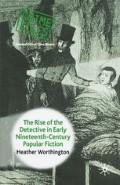Abstract
Samuel Warren was an important and popular literary figure in the nineteenth century, an author whose reputation as a fiction writer briefly rivalled that of Dickens. His popularity was short-lived: as C. R. B. Dunlop observes, ‘Warren’s reputation was at its height during the 1840s and 1850s, after which it began to decline.’1 Dunlop goes on to suggest that Warren was regarded by his successors as a member of an earlier generation of writers whose work was no longer relevant. This attitude seems to have survived into the twentieth and twenty-first centuries, as Warren has received little attention from either literary critics or cultural historians. His name appears in passing in histories of the legal profession, reflecting his role as a barrister and Queen’s Counsel and acknowledging his literary contributions to the development of the legal profession as it now exists, but the mass of his literary output lies disregarded on dusty library shelves.2 The body of his work incorporates fact and fiction, short stories, articles, book reviews, novels, and legal texts, and the subject matter is varied, as Warren made clear in the title of his collected essays, Miscellanies Critical, Imaginative, and Juridical.3 Much of his work focuses on legal, frequently criminal, matters and questions of evidence, but Warren has found no place in the canon of criminography. Yet I suggest that, in the context of the development of crime fiction and the emergence of the detective figure, Warren’s writing plays a key role.
Access this chapter
Tax calculation will be finalised at checkout
Purchases are for personal use only
Preview
Unable to display preview. Download preview PDF.
Notes
C. R. B. Dunlop, ‘Samuel Warren: A Victorian Law and Literature Practitioner’, Cardozo Studies in Law and Literature, New York 12:2 (Fall–Winter 2000), pp. 265–291, p. 284.
Samuel Warren, Miscellanies Critical, Imaginative, and Juridical, 2 Vols (Edinburgh and London: William Blackwood, 1855).
Arthur Conan Doyle, A Study in Scarlet (London: Penguin, 1981 [1887]), p. 23.
Peter Drexler, Literatur, Recht, Kriminalität: Untersuchungen zur Vorgeschichte des englischen Detectivromans 1830–1890 (Frankfurt: Peter Lang, 1991), p. 94. Translation approved by author.
Robert Morrison and Chris Baldick, ‘Introduction’, Tales of Terror from Blackwood’s Magazine (Oxford and New York: Oxford University Press, 1995), p. xvii.
Edgar Allan Poe, ‘Ten Thousand a Year. By the Author of “The Diary of a London Physician.” Carey and Hart, Philadelphia’, in Graham’s Magazine November (1841), reprinted in The Complete Works of Edgar Allan Poe, Vol. X: Literary Criticism Vol. III, ed., James A. Harrison (New York: AMS Press Inc., 1965), pp. 210–212, p. 210.
Cited in the Preface to the 1838 edition of Passages, written by Warren himself. Preface, Passages from the Diary of a Late Physician (London: William Blackwood and Sons, 1842 [1838]), pp. v-xi, p. ix.
Samuel Warren, ‘Who is the Murderer? A Problem in the Law of Circumstantial Evidence’, Blackwood’s Edinburgh Magazine 51:319 (May 1842), pp. 553–578; ‘The Mystery of Murder and its Defence’, Miscellanies, Vol. 2, pp. 1–68.
Richard Altick, The English Common Reader: A Social History of the Mass Reading Public 1800–1900 (Columbus: Ohio State University Press, 1998 [1957]), p. 332.
Cited in Hutter, Albert D. and Miller, Mary W., ‘“Who Can Be Trusted?”: The Detective, An Early Journal of Detection’, Mystery and Detection Annual 23 (1973), pp. 167–192, p. 167. The Detective ran from 10 December 1859 to 3 March 1860.
Author information
Authors and Affiliations
Copyright information
© 2005 Heather Worthington
About this chapter
Cite this chapter
Worthington, H. (2005). Making the Case for the Professionals. In: The Rise of the Detective in Early Nineteenth-Century Popular Fiction. Crime Files Series. Palgrave Macmillan, London. https://doi.org/10.1057/9780230506282_3
Download citation
DOI: https://doi.org/10.1057/9780230506282_3
Publisher Name: Palgrave Macmillan, London
Print ISBN: 978-1-349-52042-8
Online ISBN: 978-0-230-50628-2
eBook Packages: Palgrave Literature & Performing Arts CollectionLiterature, Cultural and Media Studies (R0)

